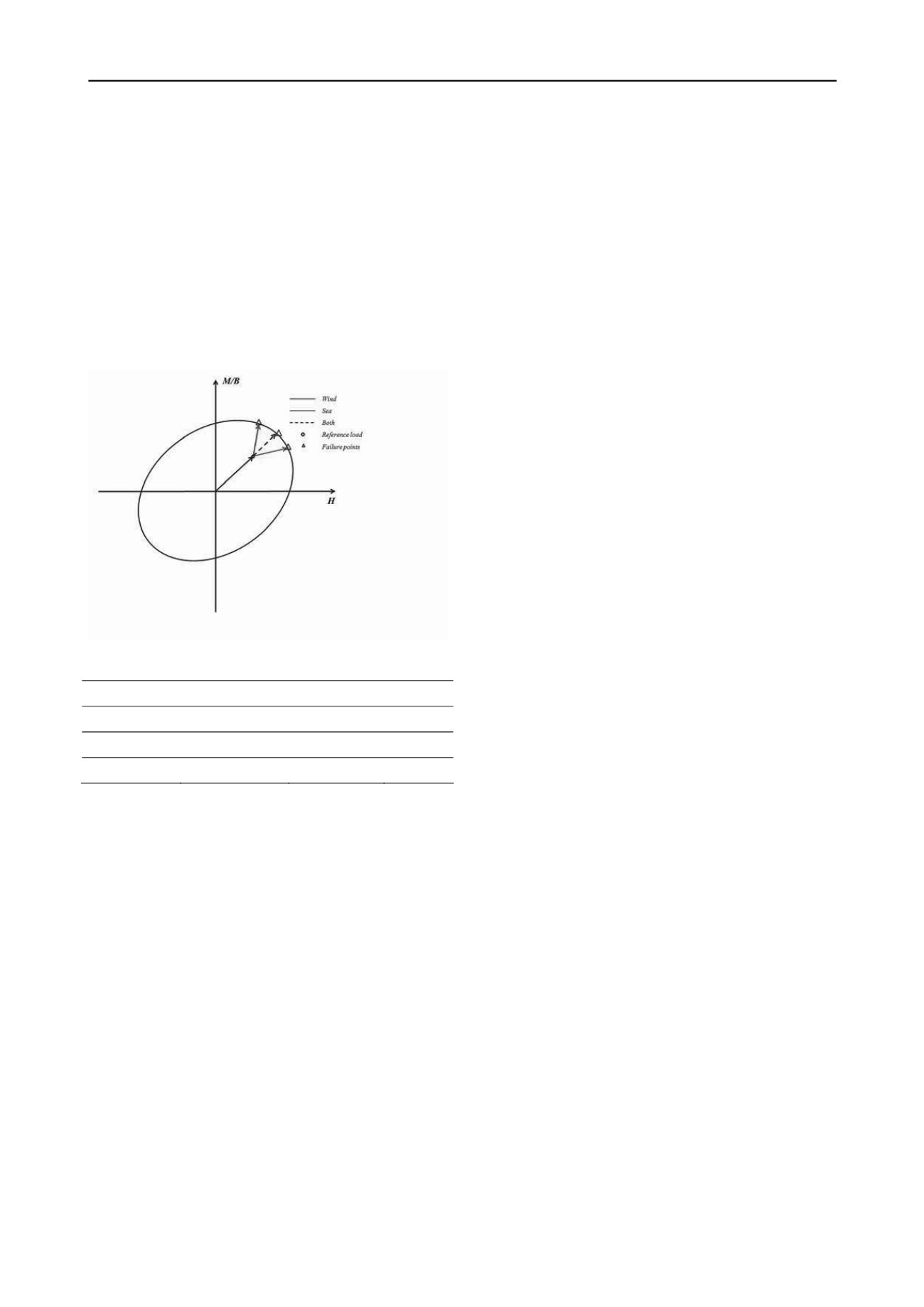
2306
Proceedings of the 18
th
International Conference on Soil Mechanics and Geotechnical Engineering, Paris 2013
ambient horizontal actions, (sea, wind) while the other remains
constant. These hypotheses would, for instance, naturally follow
from any circumstance in which the estimates of wind and wave
carry different uncertainties. Figure 4 illustrates graphically the
meaning of these load directions in an idealised section of the
failure envelope at constant V.
For this check we use the failure envelope of Gottardi et al
described above. The soil profile below the foundation is
characterised by a friction angle of 33° and submerged weight
of 10 kN/m
3
. These values might correspond well to the
characteristic values of a medium-dense sand profile, frequently
encountered in North Sea locations. It is assumed that the
foundation base is perfectly rough.
Figure 4 Incremental load paths in the example
Table 4 Example: results
Hypothesis
Hr (MN)
Hr / Hi
ΔH (%)
Sea
14.1
1.4
50
Both
11.6
1.15
15
Wind
10.5
1.04
21
Some relevant results from the computation are presented in
table 4. For each incremental loading path a failure point is
identified in the envelope, with values (H
r
, M
r
). In the table the
value H
r
corresponding to each loading path is reported in the
first column. In the second column this value is normalized by
the reference state horizontal load. This corresponds to the
generalized safety factor defined above, which, only for the
hypothesis in which both loads are simultaneously increasing,
coincides with the “plastic overturn” safety factor of ROM 0.5-
05. As a reference the value required for that safety factor in
breakwaters is commonly above 1.3 (Puertos del Estado; 2005).
For the other two load hypothesis in which only one
environmental action is increased no similar reference exists to
judge on the computed safety factor. For these cases it is
perhaps more meaningful the number in the third column of
Table 4, where the difference between failure and reference
thrust is expressed as a percent of the reference ambient load
that is increasing. In the case computed, a 21% error in the
reference estimate of wind thrust would result in foundation
failure, whereas it would be necessary a 50% underestimate of
the hydrodynamic thrust to fail the foundation.
The previous computations have always been made under
the hypothesis of increased thrust and constant lever arm. This
can be interpreted as action magnitude uncertainty. Alternative
hypothesis dealing with lever arm uncertainty can be equally set
up with relative ease. Note, finally, that most geotechnical
uncertainty can be lumped in the V
0
estimate to achieve a
relatively straightforward approach to reliability evaluation.
5 CONCLUSION
Failure envelopes offer a powerful framework to analyze
shallow foundation capacity problems. They seem particularly
suitable for offshore wind towers, where refined design in the
face of large load uncertainties is likely to be a frequent
situation.
6 ACKNOWLEDGEMENTS
The research on direct foundations for offshore wind towers
described in this paper was partly founded by the company
ACCIONA ENERGY within the framework of the CENIT-
AZIMUT project supported by the Spanish Ministry of Science.
7 REFERENCES (TNR 8)
Brinch-Hansen J. (1970). A revised and extended formula for bearing
capacity.
Danish Geotechnical Institute Bulletin
, n° 28, 5-11
Bülow, L., Jorgensen, L. and Gravessen, H. (2009)
Kriegers Flak
Offshore Wind Farm. Basic data for conceptual design of
foundations
. March 2009, Vattenfall Vindkraft AB
Burton, T., Sharpe, D., Jenkins, N. and Bossanyi, E. (2011)
Wind
Energy Handbook, 2nd Edition
, John Wiley & Sons, Chichester,
UK
Butterfield R., Ticof J. (1979). The use of physical models in design
(discussion).
7th European Conference on Soil Mechanics and
Foundation Engineering
, Brighton, UK, Vol.4, 259-2
Georgiadis, M (1985) Load-path dependent stability of shallow
footings, Soils & Foundations, 25,1, 84-88
Gottardi, S., Houlsby, G.T. y Butterfield, R. (1999) Plastic response of
circular footings on sand under general planar loading,
Géotechnique 49, No. 4, 453-469
Gourvenec, S. y Randolph, M. (2011)
Offshore geotechnical
engineering
, Spon Press, New York
DNV (2010) DNV-OS-J101
Design of offshore wind turbine structures
IEC 61400-3 (2009) International standard
Wind turbines –Part 3:
Design requirements for offshore wind turbines
. International
Electrotechnical Comission
Lesny, K. (2010)
Foundations for offshore wind turbines : tools for
planning and design
, VGE, Essen
Lesny, K. (2007) Design approaches of Eurocode 7 and their effect on
the safety of shallow foundations,
ICASP10, Applications of
statistics and probability in Civil Engineering
, Taylor & Francis
Martin, C., M., Houlsby, G. T. (2001) - Combined loading of spudcan
foundations on clay: numerical modeling.
Géotechnique
, 51, No. 8,
pp. 687 – 699
Nova R. y Montrasio L. (1991). Settlements of shallow foundations on
sand.
Géotechnique
, vol.41(2), 243-256.
Peire, K., Nonneman, H. & Bosschem E. (2009) Gravity Base
Foundations for the Thornton Bank Offshore Wind Farm.
Terra et
Aqua
, N. 115, pp. 19–29
Puertos del Estado (2005) ROM 0.5-05
Recomendaciones Geotécnicas
para
Obras
Marítimas
y
Portuarias,
Sieffert, J.G., y Bay-Gress, Ch. (2000). Comparison of the European
bearing capacity calculation methods for shallow foundations;
Geotechnical Engineering, Institution of Civil Engineers
, Vol. 143,
pp. 65-74
Van der Tempel, J. y Molenaar, D.P. (2002) Wind turbine structural
dynamics – a review of the principles for modern power generation,
onshore and offshore, Wind Engineering, 26,4, 211-220
Vesic, A. S. (1975) Bearing capacity of shallow foundations, Ch. 3 in
Winterkorn H.F. & Fang H.Y.,
Foundation Engineering Handbook
,
Van Nostrand Reinhold


